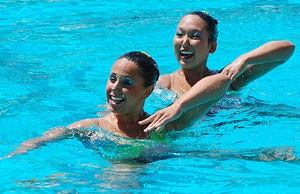UA President Robert Shelton admitted he didn’t know much about synchronized swimming, but he was given a complete education Saturday as he watched the final rounds of the U.S. Synchronized Swimming National Championships held at the Student Recreation Center pool.
As the nation’s best synchronized swimmers completed one acrobatic feat after another, such as vaulting their teammates out of the water to complete aerial back-flips, Shelton was visibly impressed. After the show was over, a judge leaned over to ask him what he thought about the spectacle.
“”I don’t know how they do it,”” he said with a laugh. “”It’s remarkable.””
The reaction was exactly what Arizona’s club team, the Splashcats, was hoping for when it placed its bid to host the sport’s most prestigious meet. Team president Jessica Barwell hoped the tournament would make waves in the desert for their relatively obscure sport and maybe even help nudge the Splashcats toward becoming a Division-I sport.
“”It’s an important opportunity as a club to host such an important meet, especially because we’re hoping to obtain varsity status,”” Barwell said.
While synchronized swimming is a club sport at Arizona, the team swims in a big pond. Synchronized swimming is recognized as an “”emerging sport”” by the NCAA, which means there is no NCAA title. With only eight varsity programs in the country, clubs and D-I teams compete at the same events. That means the Splashcats get into the pool with the likes of D-I programs such as national collegiate champion Stanford which have the scholarship and recruiting dollars to attract some of the nation’s best athletes. Still, the Splashcats held their own, placing sixth overall at the Collegiate National Championships, and first among all club teams. Arizona also boasts the best grade point average of any synchronized swimming team in the country – posting a Dean’s List winning 3.678.
The competition held this weekend brought together not only college varsity and club teams, but also non-academic club teams such as the Santa Clara Aquamaids (not affiliated with Santa Clara University). The Aquamaids practice eight hours a day and have produced past and present Olympians, so Arizona truly is swimming with the best of the best.
“”This (competition) is just one more confirmation that though we are a club, we are elite athletes also,”” said head coach Jill Ranucci.
While many of the Splashcats would like to be recognized as a D-I team, it’s not just important to Arizona. Creating varsity programs is also on the national agenda for a sport whose leaders want it to break out of its niche mold.
“”For us it’s urgent,”” said U.S. Synchronized Swimming President Ginny Jasontek. “”We want to work towards an NCAA Tournament. We need to keep showing growth, to keep emerging.””
Jasontek said talking to university presidents like Shelton as well as other officials is part of her organization’s strategy to increase exposure for the sport. The hope is that strong club teams like Arizona will eventually become varsity teams. Jasontek feels that the athletes are there, but the programs aren’t.
“”We have the athletes, we need the schools to make it happen,”” she said.
Jasontek and Ranucci said it’s been difficult to win recognition for Arizona because the Pacific 10 Conference only has one D-I team, Stanford. Six teams are needed to hold a Pac-10 tournament.
Ranucci said the weekend’s meet showed that synchronized swimming in Arizona and the Pac-10 was strong and getting stronger.
“”This is an affirmation for the Pac-10,”” she said. “”Santa Clara has three teams; each athlete could be competing in Pac-10 area schools. The Pac-10 could dominate synchro swim.””
She also said while Arizona has seven strong age-group clubs in Arizona for younger swimmers, but without a varsity program, Arizona might lose those athletes to schools with varsity programs.
“”We have the swimmers to feed the program,”” she said.
Stanford coach Heather Olson said she would welcome the added competition.
“”They’re a club team, but hopefully with the exposure from this meet the university will consider making them varsity. It’d just be great to have more varsity teams to compete with in the Pac-10,”” she said.
Shelton didn’t specifically weigh in on the future of synchronized swimming at Arizona, but he didn’t rule it out either.
“”Well it all boils down to money doesn’t it? But when you look at the athleticism you can certainly see why it’s caught on,”” he said. “”When you think about the traditional power the UA is in aquatic sports, it’s great that we’re hosting this event.””









